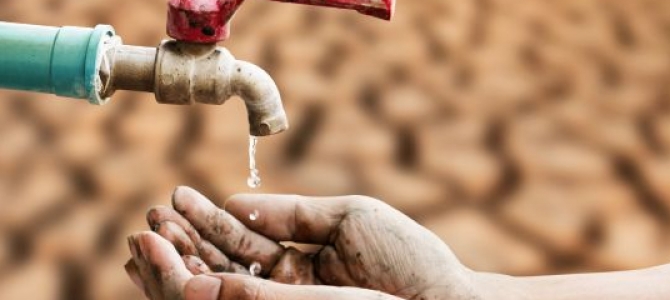 Shopping Cart
Shopping Cart
05 June 2025
Drought Outlook 2025–2026: A Look at Average Rainfall Data Worldwide and Current Trends

Drought remains a critical concern for water management, agriculture, and communities worldwide. As climate patterns shift and global temperatures rise, understanding the latest drought trends and adopting advanced water-saving technologies is more important than ever.
Below, we update our December 2023 analysis to reflect current climate projections for the summer of 2025 in the Northern Hemisphere and the upcoming summer of 2026 in the Southern Hemisphere, with a focus on the USA, Australia, and New Zealand.
Global Climate Trends and Drought Context
Currently, there's an alarming increase in drought-like conditions in various parts of the world. Climate change, marked by rising global temperatures, is exacerbating the frequency, intensity, and duration of droughts. According to the United Nations, over 1.5 billion people worldwide are impacted by droughts, leading to water shortages, failed crops, and increased fire risks.
Regions like the Western United States, parts of Australia, and several areas in Africa are bearing the brunt of prolonged dry spells. The U.S. Drought Monitor, for instance, reports that over 72% of land in Western U.S. states is currently experiencing drought. Similarly, the Australian Bureau of Meteorology states that certain regions in Australia have witnessed below-average rainfall over the past few years, leading to severe drought conditions.
These trends pose significant threats to local ecosystems, agriculture, and human communities. Ecosystems are experiencing a shift in biodiversity, with certain species struggling to survive in drier conditions, while agricultural practices are being heavily impacted, leading to food insecurity. For human communities, especially in developing regions, drought can exacerbate poverty and trigger migration. It's crucial to understand these trends and implement effective mitigation strategies to safeguard our planet's future.
According to NOAA and other leading climate authorities, the past decade has seen a string of record-breaking warm years, with the Northern Hemisphere experiencing its hottest summers on record in both 2023 and 2024. These trends are projected to continue, driven by ongoing greenhouse gas emissions and persistent warming of sea surface temperatures.
“The temperature-related extreme events witnessed this summer will only become more intense, with more devastating consequences for people and the planet unless we take urgent action to reduce greenhouse gas emissions.”
– Samantha Burgess, Deputy Director, Copernicus Climate Change Service
For a comprehensive overview of global temperature projections, see NOAA’s climate.gov resource.
Exploring the Impact of Climate Change on Global Rainfall
Climate change has far-reaching implications for global rainfall patterns. As the Earth's temperature rises, the overall hydrological cycle intensifies, leading to an increase in both evaporation and precipitation. This means that while some regions experience more frequent and severe droughts, others are besieged by intense rainfall and, consequently, flooding.
The effects of these altered patterns are far from uniform. For instance, while tropical regions are generally expected to see an increase in rainfall, many subtropical areas (such as the Mediterranean and parts of Australia) are projected to become much drier.
The impacts of these changes on humans and ecosystems can be devastating. Increased precipitation in certain regions can lead to flooding, causing damage to infrastructure, loss of life, and displacement of communities. On the other hand, drier conditions can exacerbate water scarcity issues, negatively affect agriculture, and lead to loss of biodiversity.
Understanding these shifts in rainfall patterns is vital for informing policy decisions around water management, agriculture, and disaster preparedness. It's clear that addressing climate change must be a priority to mitigate these potentially catastrophic shifts in our global weather systems.
USA: Summer 2025 Drought and Heat Outlook
Temperature and Precipitation
- NOAA’s Climate Prediction Center forecasts hotter-than-average temperatures across the entire United States for summer 2025, with no region expected to experience a cooler-than-average season.
- The greatest likelihood of extreme heat is on the East Coast, the southern Plains, and the West.
- The Northwest, Northern Rockies, and Great Plains face higher chances of below-normal precipitation, increasing drought risks.
Drought Hotspots
- Southwest and southern Texas are entering summer in Extreme and Exceptional Drought (D3–D4), with drought expected to persist.
- The Northern Great Plains and Northern Rocky Mountains are also in Moderate to Extreme Drought, with forecasts indicating continued or worsening conditions.
- The Eastern U.S., especially Florida and the Mid-Atlantic, is expected to see some drought relief as the rainy season progresses.
Wildfire Risk
- Significant wildfire risk is forecast for the Southeast, central Texas, the Four Corners, California, and the Pacific Northwest through the summer.
ENSO Status
- ENSO-neutral conditions are favoured through the Northern Hemisphere summer of 2025, meaning neither El Niño nor La Niña is expected to dominate, but uncertainty increases later in the year.
Australia: Outlook for Summer 2025–2026
Climate Drivers
- Australia is likely to experience a rare late-season La Niña event by the end of the 2024–2025 summer, which typically brings wetter conditions, especially to eastern Australia.
- Sea surface temperatures remain well above average, intensifying concerns over climate change and its impact on rainfall patterns.
Rainfall and Drought
- The Bureau of Meteorology (BOM) expects a wet finish to the 2024–2025 summer, with heavy rainfall already observed in Sydney and other parts of the east coast.
- While La Niña generally reduces drought risk in eastern Australia, the country remains vulnerable to rapid shifts in climate patterns, and long-term warming trends continue to threaten water security.
Long-Term Trends
- CSIRO’s State of the Climate report highlights that Australia’s climate is warming, with more frequent extreme weather events and shifting rainfall patterns.
New Zealand: Seasonal Climate Outlook
Winter 2025 and Beyond
- NIWA forecasts above-average temperatures across all regions for June–August 2025, with rainfall totals expected to be above normal in the north of the North Island and near normal elsewhere.
- ENSO-neutral conditions are expected to persist, but intermittent weak La Niña-like atmospheric patterns may still occur.
- Sea surface temperatures remain well above average, with marine heatwaves affecting large offshore regions.
Soil Moisture and River Flows
- Near-normal soil moisture and river flows are forecast for most regions, reducing immediate drought risk, but continued monitoring is advised.
Long-Term Climate Scenarios
- For detailed projections, see NIWA’s climate scenarios resource.
Global Drought and Water Supply Concerns
Drought is a growing global challenge, as rising temperatures and shifting rainfall patterns threaten water supplies, agriculture, and ecosystems. Even regions that experience wetter periods remain vulnerable to rapid changes, highlighting the need for resilient water management strategies.
What We Can Do to Mitigate Drought and Ensure Adequate Water Supply
In response to these escalating challenges, it's crucial to adopt multifaceted strategies to mitigate drought and ensure an adequate water supply. Firstly, we need to employ smart water management practices. This includes water recycling, rainwater harvesting, and efficient irrigation techniques, which can significantly reduce water waste and maximise available resources.
Secondly, investing in drought-resistant crops and innovative agricultural practices can help to lessen the impacts of drought on food production. These practices not only offer a sustainable solution for food security but also contribute to the resilience of rural communities, which are often the hardest hit.
Lastly, substantial effort is required for widespread education and awareness about water conservation. Encouraging individuals, communities, and industries to reduce their water usage can make a significant difference. It's also important to recognise that the preservation of water resources is intrinsically linked to the broader fight against climate change. Therefore, endeavours aimed at reducing greenhouse gas emissions, such as transitioning to renewable energy sources and promoting sustainable transportation, will inherently contribute to the stability of our global water supplies.
How to Conserve Water in Your Home and Workplace
Rainwater harvesting is a crucial practice that can help conserve water in both homes and workplaces, making countries like New Zealand, Australia, and the US more water-efficient. These countries, facing water scarcity due to climatic changes and population increase, have started to recognise the potential of rainwater harvesting.
In New Zealand, rainwater collection systems are being incorporated into new buildings in urban and rural settings. Utilising the country's plentiful rainfall, this water is used for non-potable purposes such as flushing toilets and watering gardens, reducing reliance on municipal water supplies.
Australia, a country known for its dry climate and long periods of drought, is a global leader in household rainwater harvesting. With government rebates available to homeowners installing rainwater tanks, Australians have been encouraged to adopt this practice not only for their gardens but also for indoor uses like laundry and toilet flushing.
In the US, rainwater harvesting is becoming increasingly prevalent, particularly in drought-prone states like California and Texas. Here, rainwater is collected from roofs and stored in barrels or cisterns, providing an alternative water source for irrigation, washing cars, and sometimes even for drinking, following appropriate treatment.
As this practice gains traction globally, it is vital to explore and invest in efficient rainwater harvesting systems, ensuring they are optimised for the local climate and rainfall patterns. This will ensure a sustainable water future for homes and workplaces worldwide.
Technologies to Reduce Water Waste
Smart Water’s Leading Solutions
- Smart Water Tank Level Indicator technology empowers users to monitor and manage water use efficiently, reducing waste and supporting sustainable water supply during droughts.
- Our systems provide real-time data, leak alerts, and integration with smart irrigation, helping households, farms, and businesses optimise their water resources.
Other Innovations
- Smart irrigation controllers
- Leak detection systems
- Water-efficient appliances and fixtures
- Rainwater harvesting and greywater recycling
For more on how technology can help reduce water waste, explore related articles in the Smart Water news section.
Conclusion
The outlook for 2025–2026 underscores the continued risk of drought and extreme heat, especially in the USA, with variable but generally warmer and wetter conditions in Australia and New Zealand. Leveraging advanced water management technologies, such as those offered by Smart Water, is essential for building resilience in the face of ongoing climate change.
For the latest updates on drought, water management, and climate trends, visit:
Stay informed and prepared—monitor your water, reduce waste, and help secure a sustainable future.
Blog first published on 15 December 2023 and last updated on 5 June 2025
Frequently Asked Questions
How do marine heatwaves impact weather patterns and drought risk?
Marine heatwaves—periods of abnormally high sea surface temperatures—can influence atmospheric conditions, intensify storms in some areas, and reduce rainfall in others. They also disrupt marine ecosystems and can reinforce drought conditions by altering wind and precipitation patterns.
How do droughts affect groundwater levels and long-term water supply?
Droughts reduce surface water availability and lead to increased reliance on groundwater. Over time, this causes aquifers to deplete, especially in areas with poor recharge rates, threatening long-term water sustainability for drinking, agriculture, and industry.
What role do forests and wetlands play in mitigating drought impacts?
Forests and wetlands act as natural water regulators. They store and slowly release water, help recharge groundwater, and maintain local humidity levels. Preserving these ecosystems can buffer the effects of drought, prevent erosion, and support biodiversity.
